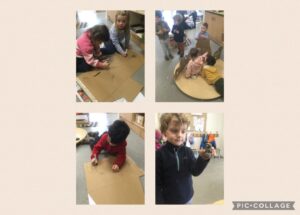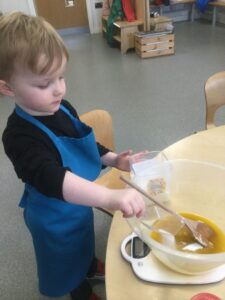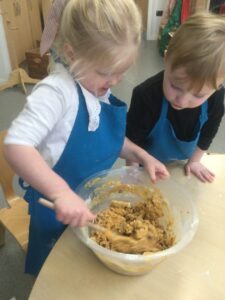At Cart Mill this week the younger children have been exploring the clay in the new 2-3 room called the pond.
We started off with a big block of clay and discussed what clay is. The children describe it as playdough. Yes, it’s very like playdough but clay comes from the earth. It’s cold and messy in your hands. As the children start to feel the clay. We encourage them to talk about how it feels and what do they notice about the clay.
“Hard”
“Good”
”Stuck on my fingers”
The children used their hands to pull the clay off they then explored the clay further by squeezing, rolling and piling up the clay.
“I’m getting a big bit”
”I’m rolling it”
We will continue to offer opportunity for the toddlers to use all their sense to explore the clay learning different techniques to manipulate the clay with our hands. Ie pinch, squeeze, roll and how to stick it together.
Our 3-5 children have been exploring our clay further by making clay models. With the change in season and frosty weather outside the children have been interested in making snowmen with the clay.
Recently the children have been making clay model and painting them but find the clay is fragile and can break easily. We started to discuss how we can make it stronger. The children suggested things like we need to be careful with it, not rolling it to thin and make it bigger. I suggested to make the clay hold together we could add some small sticks in the middle of the clay to hold the snowman’s body together. While making the snowmen we challenged the older children to split their clay into 3 parts using the language of quality such as ‘some’ ‘a bit’ and ‘equal’
while we waited for our clay snowmen to dry. We set about making a winter wonderland town backdrop to play with our snowmen. This involved drawing some houses on cardboard and cutting it out to create our sky line.
With the clay taking a long time to dry. The children have been enjoying lots of role play with the stone people and are excited to see there snowmen dry to paint and play with.
Our snowmen have been a huge hit with the children. Some children have started to create a whole family of snowmen. ☃️⛄️☃️⛄️









































